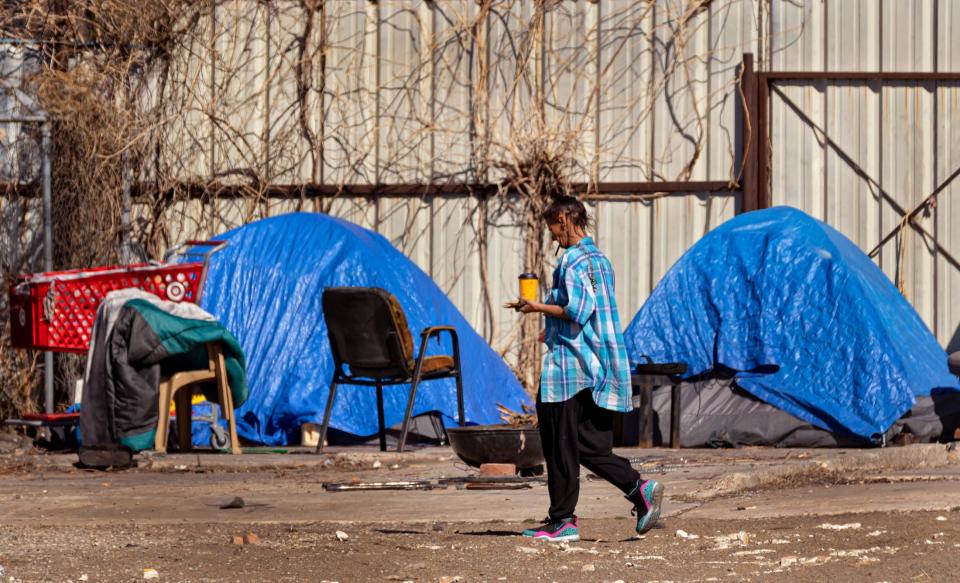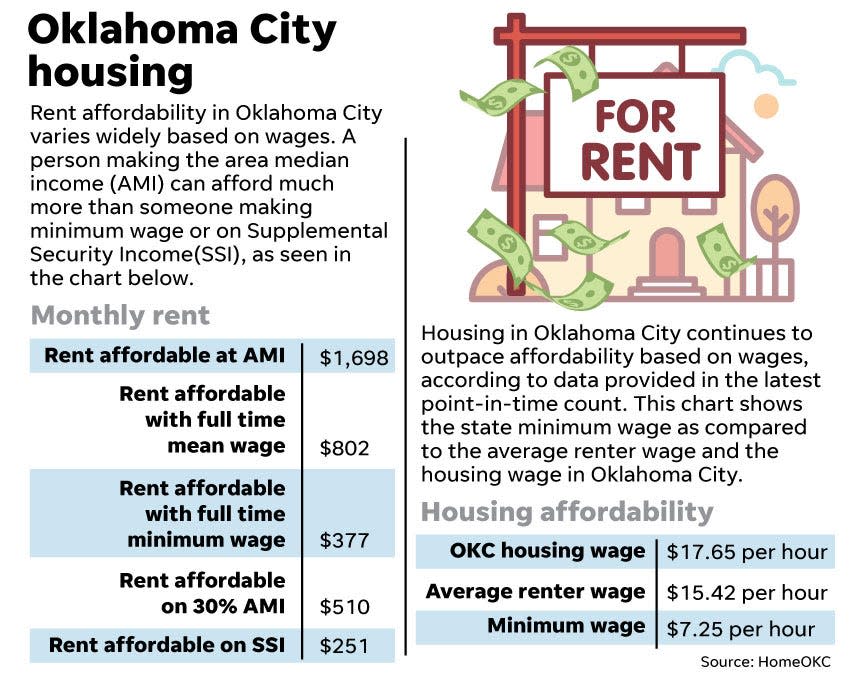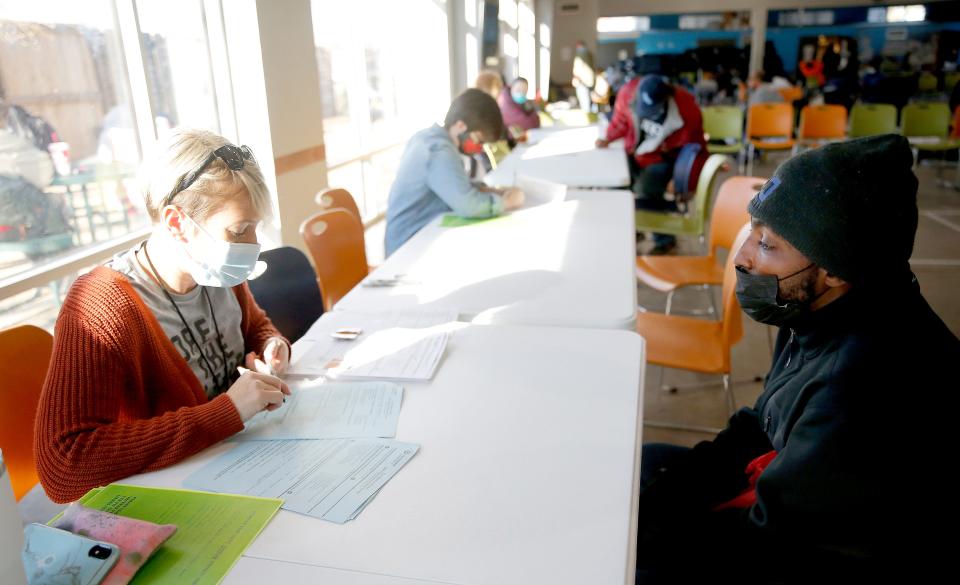Homeless count highlights need for continued investments in OKC affordable housing
The results of Oklahoma City's annual homeless count were released Wednesday, and despite a decline in the number of people counted, area homeless service providers say consistent issues remain across the city, especially concerning affordable housing.
This year's point-in-time count registered 1,339 individuals experiencing homelessness in Oklahoma City. The number, while down from the 2020 count of 1,573, represents an increase from the counts in 2018 and 2019.

“It's definitely not something significant enough to get excited about,” said Jerod Shadid, program planner for the city of Oklahoma City’s Homeless Services. “That's still a very high number.”
One of the city's biggest recurring issues, the lack of truly affordable housing, continues to increase as rents rise and wages remain stagnant, Shadid said.
Minimum wage in Oklahoma has not increased since 2009, with the state matching the federal rate of $7.25 per hour.
According to data from area homeless services providers, a person would need to work 71 hours per week at minimum wage to afford a one-bedroom apartment in Oklahoma City at fair-market rent of $670. A two-bedroom apartment at fair-market rent, $847, would require a person making minimum wage to work 90 hours per week.
The quest for 'truly affordable' housing
Oklahoma City is often referred to as one of the most affordable places to live, but Shadid and Dan Straughan, executive director of the Homeless Alliance, say affordability is relative to whom housing is being marketed.
"When Realtors and Chamber of Commerce people say affordable housing, they're talking about housing that is affordable to people that are making 80% to 120% of AMI (area median income), and AMI in Oklahoma City is around 50 grand,” Straughan said. “So if you're making 40 to 60 (thousand dollars), we have a decent housing market for you, but in Oklahoma City, we have 135,000 people that live at or below the poverty line, and that's 12,000 (dollars).”

The difference in affordability for a family making $40,000 a year and one making $12,000 a year is stark, he said.
"Until we invest in truly affordable housing with supportive services, so financial supports and mental health treatment and substance abuse treatment and education, and job training and placement, those sorts of things, these numbers are going to stay pretty much the same,” Straughan said.
Shadid said an "unfortunate stigma" exists surrounding those in need of assistance for housing or other basic needs.
The housing wage for the city is $17.65 per hour. That rate is more than $10 above the minimum wage and only about $2 less per hour than the annual pay for a first-year teacher in Oklahoma City Public Schools.
The Housing and Urban Development Department defines a household as "cost burdened" if it spends more than 30% of its monthly income on rent.
“A lot of people who fall on this rung of the ladder, they can't pay their rent without paying more than 30%, and when you're cost burdened like that on just your housing, it basically puts you in day-to-day emergency mode,” he said. “You're basically addressing crisis every day, and when you're doing that, just figure out how you're going to pay the rent, pay the utilities, pay for food.”
Report: Oklahoma County needs more than 4,500 affordable housing units
According to the point-in-time count report, Oklahoma County lacks more than 4,500 affordable housing units. The city's MAPS 4 project has earmarked $50 million for programs aimed at addressing homelessness in the city, including "housing first" and "truly affordable housing" models. These programs are intended to create housing that benefits those living below the area median income.
Additional federal funding is being paired with the city's investments, which should allow homeless services providers to have a "really significant impact," Shadid said. It's not a perfect, or immediate, fix to the problem though, he says.
“It is really great to have what we've got coming in, but we can't take our eye off the ball of basically longer-term sustainable solutions," he said.
The city needs units in the market now, not several years in the future when MAPS 4 units are expected to be completed, he said.
Each year the point-in-time count includes those living in shelters, unsheltered homeless and those in transitional housing programs. The count does not take into account "couch homeless," including those living with friends or family, those incarcerated, in treatment facilities, hospitals or hotels at the time of the count. The count offers a snapshot for a very specific day and time.

While the overall number of people counted March 3 decreased, Straughan said there was a common theme of consistency across demographics.
"Veterans have been 10% of our homeless population since like 2015 and families have been 16% from like 2012,” he said.
Similarly, the number of unsheltered and chronically homeless have continued to trend upward in the last several years, Shadid said. However, 48% of those encountered during the 2022 survey were experiencing homelessness for the first time.
Straughan said this uptick is attributed to the pandemic and bolsters the argument for more investment in prevention services, which was "pretty scarce," before the pandemic. However, the funding provided for prevention during the pandemic is "time limited," and he said the city will have to find new ways to address that challenge when it lapses.
This year's count also collected data on where people became homeless. Overwhelmingly, those encountered had become homeless while living in Oklahoma with 83% living in the state and 69% living within Oklahoma City. Straughan said this data is important because it dispels a common myth that Oklahoma City's homeless population are coming from other states.
This article originally appeared on Oklahoman: Annual homeless count decreases, but OKC affordable housing still lags

